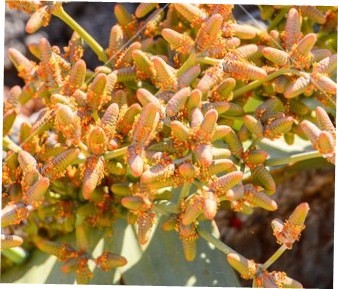Tree tumbo
(Welwitschia mirabilis)

Description
Welwitschia is a monotypic gymnosperm genus, comprising solely the distinctive Welwitschia mirabilis, endemic to the Namib desert within Namibia and Angola. The plant is commonly known simply as welwitschia in English, but the name tree tumbo is also used. It is called kharos or khurub in Nama, tweeblaarkanniedood in Afrikaans, nyanka in Damara, and onyanga in Herero. Welwitschia is the only living genus of the family Welwitschiaceae and order Welwitschiales in the division Gnetophyta, and is one of three living genera in Gnetophyta, alongside Gnetum and Ephedra. Informal sources commonly refer to the plant as a "living fossil". Welwitschia mirabilis is endemic to the Kaokoveld Desert, which lies within the Namib Desert. The population is distributed southwards from the Bentiaba River in southern Angola, to the Kuiseb River in Namibia, and up to 100 km (62 mi) inland of the coast. The area is extremely arid; the coast is recorded as having almost zero rainfall, while less than 100 mm (3.9 in) of rain falls annually below the escarpment in the wet season from February to April. Populations tend to occur in ephemeral watercourses, indicating a dependence on groundwater in addition to precipitation from fog. Welwitschia is named after the Austrian botanist and doctor Friedrich Welwitsch, who was the first European to describe the plant, in 1859 in present-day Angola. Welwitsch was so overwhelmed by the plant that he, "could do nothing but kneel down and gaze at it, half in fear lest a touch should prove it a figment of the imagination." Joseph Dalton Hooker of the Linnean Society of London, using Welwitsch's description and collected material along with material from the artist Thomas Baines who had independently recorded the plant in Namibia, described the species. Welwitsch proposed calling the genus Tumboa after what he believed to be the local name, tumbo. Hooker asked Welwitsch for permission to name the genus Welwitschia instead. Welwitsch concurred and supplied some well-preserved material from which Hooker was able to make substantial progress in determining its botanical affinities. The taxonomy of Welwitschia subsequently changed intermittently with the development of new classification systems (see Flowering plants: History of classification), however, its current taxonomic status is essentially the same as Hooker's placement.
Taxonomic tree:







